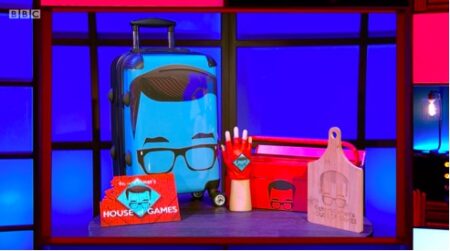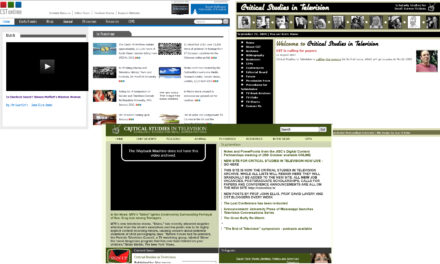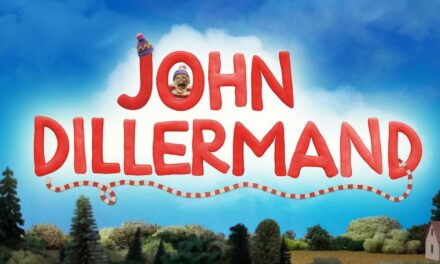How are we all getting on, then? I have just heard that London is moving into Tier 2 at the weekend (or last weekend, by the time you read this), but to be honest it won’t make all that much difference to me, as I rarely welcome people across my threshold at the best of times.
As to work, I must say the time is flying by – but not always in a positive sense. As a non-practice tutor, it was agreed that my teaching would all take place online this trimester, which saves me the hassle (and, let’s face it, associated risks) of travelling up to Salford (bus, Tube, train ’n’ tram) and staying in cheap rented accommodation every week. Rather than pre-record my lecture content and then deliver live online seminars, I have opted to do the whole thing in real time on the internet, thus giving students the opportunity to ask questions during the main class, as I normally would. On my second and third year modules, what would usually be a three-hour ‘workshop’ (combining lecture content, screenings and seminar-style activities), is now delivered as a 90-minute ‘lecture’ (everything seems to take more time online), followed by a half-hour break, and then a 90-minute ‘workshop’ (i.e. more activity-based). These cohorts range between twenty-four and thirty-four students, and so far it has proven manageable, at least in didactic terms. I must admit I find the amount of energy required to keep the tone upbeat draining, and if the passage of time feels accelerated it is because I am having to concentrate so intensely at every stage. Even when the class goes well, I usually feel in need of a nice lie down afterwards. The worst aspect, I think, is the isolating sense of speaking out into the void, accompanied by the paranoid fear that the connection has gone down and my students are no longer hearing a word I say. In a physical teaching space it is of course disheartening when students visibly fail to engage (this rarely happens during my lectures, obviously), but at least the tutor knows where they stand in terms of the class dynamic. For the most part, my current online teaching could be going like gangbusters or landing like a lead balloon, and I am really none the wiser either way – unless the audio is missing from my screening clips, in which case students are usually quick to let me know (and blip! blip! blip! goes the text box). I’m growing more used to it now (along with all the rapid switching between screens and ticking of boxes that is required in order to play clips, show slides, or organise students into breakout groups), but it is not my natural milieu, and – due to my reluctance to review the video recordings of my teaching so far (colleagues who have done so complain they look like hostage videos) – I really don’t know how it is looking at the students’ end. It’s nice at the end of the class when the ‘thank you’ messages arrive (blip! blip! blip!), but overall the whole thing is a bit of an ordeal. A former boss once voiced the opinion that my lecturing duties were not all that arduous (all you have to do is stand up and talk, apparently), but even if that were true, this online business feels a lot more demanding.
For the moment, however, there is no safe practical alternative, and I’m currently spending between six and nine hours a week talking at my computer screen. Of these, the least difficult session is, I think, the first year teaching. This involves a one-hour live online lecture, followed later in the day by two workshops (basically seminars, but with twice the number of students that could be fitted into a seminar room), which I alternate with other tutors. Our new first years have not yet learned to be inhibited – perhaps because they are not seated in a lecture hall – so there is constant text feedback (blip! blip! blip-blip-blip!), which – while occasionally distracting when I am trying simultaneously to focus on my slides and clips without talking total gibberish – at least lets me know that they are out there, and receiving loud and clear.
My timetable is such that teaching has always concluded by 6 pm,[1] when I (somewhat joyously) close my work email tab, reach for a large glass of Primitivo,[2] and settle down to watch Richard Osman’s House of Games on BBC Two. If you haven’t seen it, this is a game show in which four celebrities (only some of whom I haven’t heard of) compete over the course of five evenings to win the weekly trophy – although the winner on each evening can also choose one item from that day’s election of prizes, all of which are branded with the programme logo: a stylised representation of Richard’s face, set against a distinctive red and blue colour scheme. The latter means that although the prizes, which are typically comprised either of the functional or the homely (alarm clock, bath robe, calculator, onesie, oven gloves, dartboard), look acceptable enough when displayed to contestants, tantalisingly, at the start of the show, few of them are likely to ‘go’ with the eventual winner’s home furnishings – unless they live in a house decorated primarily in distinctive red and blue, as the studio set is. Perhaps worryingly, my favourite prizes are always alcohol related: my top three picks are the decanter, hip flask and cocktail shaker. Of the rest, the fondue set is much smaller than it initially seems once handed over, but the wheelie suitcase looks to be a sturdy enough item, and would be difficult to miss on the luggage carousel.
Although Richard Osman has previously assisted Alexander Armstrong in the hosting of Pointless Celebrities, and also had his own quiz, Two Tribes, which pitted members of the public against each other, this is the first time he has hosted a celebrity game show solo, and it’s all very convivial. The competitors are seated in a row of the same four chairs every evening, though there is a pair round in which the lowest scoring celebrity of the moment is allowed to choose their partner. This particular game of musical chairs can result in some dubious tactical play as the lowest scorer sometimes plumps to work with the highest, either in order to increase their own score or to sabotage the other’s. The pair work relies on each member providing one half of a correct answer, and can result in both ecstasy (the uncanny symbiosis between Scarlett Moffatt and Naga Munchetty in last week’s Champions episode being a case in point) or tangible frustration (witness Rick Edwards’ acerbic interactions with David O’Doherty in the same episodes). Sometimes competitors opt to stay in their allocated seats throughout the week, which suggests that unshakeable green room alliances have already been forged; the unforeseen bond of affection rapidly established between Gyles Brandreth and Angellica Bell springs readily to mind.
The host is positioned to the left of the screen, is clearly as unaware of the answers to the questions as his guests, and often shares their incredulity at what turns out to be the correct factual response. This generally adds to the overall sense of a lovely parlour game being played amongst friends.
The Chase this is not.
In keeping with this spirit of light-hearted bonhomie, Mr Osman is also prone to awarding points to near-miss answers that are not entirely merited, depending on his mood. He is particularly guilty of this in the Blast from the Past Tense round, wherein a clue is given to an answer that must be supplied in (yes, you guessed it) the past tense. As a former EFL teacher, I occasionally take issue with contestants being allowed to get away with using the regular ‘-ed’ ending for verbs that are in fact irregular. For example, can you name the 1994 film that starred Keanu Reeves and Sandra Bullock?
For me, the answer should be Sped; the past simple of Speed (do you understand now?). Richard allowed Speeded, which might just be acceptable (as in ‘speeded up’ – which is, besides, a phrasal verb, and has a separate meaning from the action ‘to speed’), but did not sit as comfortably with me.
Later that round Richard went on to allow that the past tense of ‘hockey stick’ was ‘hockey sticked’, instead of ‘hockey stuck’ (are you getting the hang of it now?), by which point my initial mild indignation had turned to genuine ire.
On the whole, though, it’s all very enjoyable. It turns out that guessing a film title composed entirely of emoji, working out a song title from its year and the first letters of the opening lyrics, giving an answer backwards, or rearranging the component words of the correct answer in alphabetical order can be both entertaining to watch (particularly when it’s a publicity-hungry stand-up struggling to do it on national television) and a welcome distraction from work-related worries when playing along at home.
It’s not Only Connect (which confounds me more often than I am comfortable admitting), but it’s still a challenge.
Perhaps the weirdest round is Question Writer’s Day Off, in which the people who usually pen the conondra turn over this weighty responsibility to their school age children, who provide eight offbeat brainteasers. These questions are entirely random, and some of the answers turn out to be somewhat abstract, to say the least. For example, yesterday Nola (aged four) stumped everybody with:
‘What is Mr Grassy? I’ll give you a REALLY BIG CLUE! He lives in Mr Forbes’ classroom and is mostly green.’
Give up?
The correct response is, of course, a budgie – and not a cow, which was Ade Apitan’s equally bizarre guess.
The only round in which I make no attempt to participate is Where is Kazakhstan?, for which players are provided with tablets and asked to locate a specific location on a map. Geography has always been my weak point (along with sport). Like Sherlock Holmes, I only make the effort to memorise facts that I think likely to be of use to me – and right now, world travel is not on the agenda. I can point to London on a map (because I live there), or Rome (because I used to live there) – but I know my limitations. Unfortunately, many of the contestants do not, and the cities they have been asked to pinpoint sometimes end up placed in entirely the wrong continent.
Each episode concludes with Answer Smash, which combines a specific category, for which a picture is shown, and a general knowledge question. The end of the first answer also provides the opening half of the second, thus ‘smashing’ together two answers into one freakish compound. For example, when asked to conflate a former Take That member and a TV series set in a women’s prison, the correct response is Jason Orange is the New Black (which I got). Combining a piccie of singer Sinitta and a paste made from sesame seeds that can be added to hummus should result in Sinittahini (which I didn’t).[3]
All good fun, but it becomes fiercely competitive once people start buzzing in. And it is always agonizing to see one player give an almost-correct answer, only to muff a vital syllable (e.g. Sinittatahini) and have their point snatched away from them by another, cannier contestant who has just enough sense to pronounce it correctly (Naga Munchetty largely made it to the champions’ round by employing this tactic).
House of Games started in 2017 but I only really became familiar with it this year, when it formed the crux of my early evening lockdown viewing. I felt quite bereft when it was suddenly replaced by Eggheads, but eventually settled into the new routine, amusing myself by speculating as to what Judith Keppel (my favourite Egghead) and Kevin Ashman (my partner’s) did for fun during those episodes when they were not included in the team.
But it wasn’t quite the same.
Now it’s back, and this week we have been treated to the first of the socially distanced episodes. Basically, they have just moved the chairs further apart, meaning the formula has been less visibly compromised than, say, Bargain Hunt, for which the closing celebratory kick now takes place side-on in a diagonal line.[4] This is a reassuringly familiar touchstone of early evening telly in unsettling times, and I for one am grateful – both for the diversion it offers, and for the clear (and much-needed) demarcation point it provides between teaching hours and non-teaching hours.
Dr Richard Hewett is a lecturer in media theory. He has contributed articles to The Journal of British Cinema and Television, The Historical Journal of Film, Radio and Television, Critical Studies in Television, Adaptation and SERIES – International Journal of Serial Narratives. His 2017 book, The Changing Spaces of Television Acting, was published in paperback form earlier this year.
Footnotes
[1] There were initially dark mutterings of evening and weekend classes, but these seem to have abated.
[2] This makes it sound as though I have a number of glasses of wine pre-poured, scattered liberally around my flat, and ready to sup at a moment’s notice. I don’t, but perhaps I should…
[3] I did begin putting together my own version of answer smash for this blog, using photos of well-loved CST academics, but it all became very silly very quickly.
[4] I look forward in the near future to publishing a slim volume on Lockdown TV Aesthetics.







This has been a miserable week Richard… but starting my Friday by reading this has already raised the tone *immensely*. How fascinating to learn about your new approach to teaching… and how engaging to hear about the delights of “House of Games”. May well give it a go!
Take care and stay safe.
Andrew